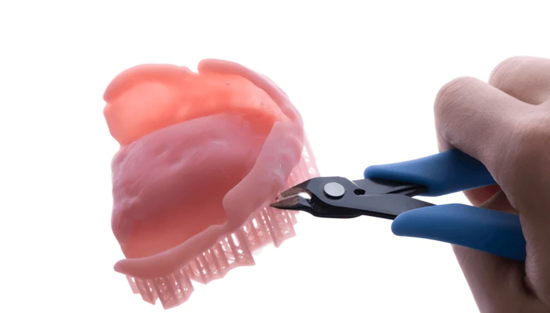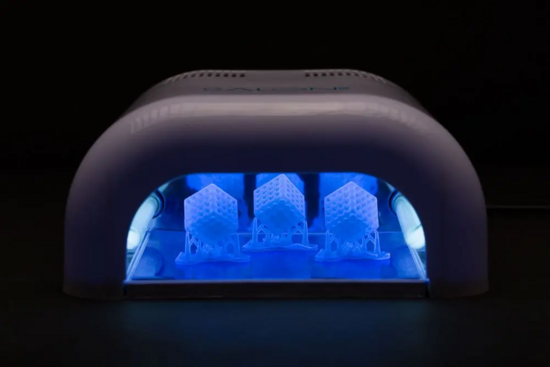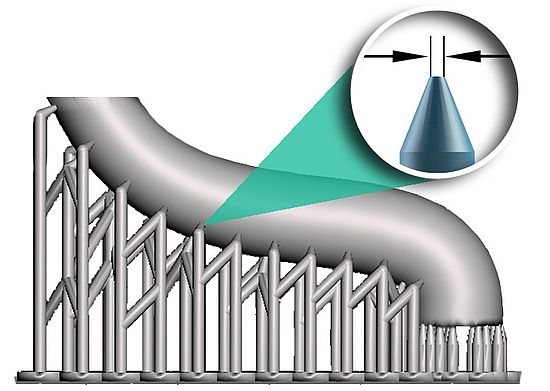
What is SLA 3D Printing?
SLA stands for "Stereolithography," which can be loosely translated as "two-part writing with liquid."
In this context, "two-part" (stereo) refers to the fact that this process requires two components: a liquid base material known as resin and a UV light source.
UV light is essential for initiating the polymerization process. In traditional SLA, a UV laser with a wavelength of 403 nm is commonly used,
although LCD displays, LED displays, or DLP projectors can also be employed in some applications.
Ultra-Thin Layers
In the SLA process, the laser "draws" the shape of the current layer through the liquid onto the platform.
Components produced using SLA are notable for being constructed from extremely thin layers.
The liquid state of the building material allows for very fine details. The diameter of the laser determines the level of detail.
Because this method does not use thermal energy, it can create miniature parts that would overheat and melt in thermal processes like DLM, FDM, or SLS.
Mature Technology
SLA is the first 3D printing process ever developed. Invented in 1984 and introduced to the market three years later, SLA technology has been continuously improved.
As a result, it is a highly developed 3D printing process today.
How Does SLA 3D Printing Work?
SLA 3D printing begins by loading a 3D model into slicing software, which breaks it down into layers and generates instructions for the printer. This software also determines the orientation of the component, a crucial factor influencing its quality. To save on material and prevent printing issues, larger components are often hollowed out instead of being solid.
When an overhang exceeds 45°, support structures are automatically generated to prevent breakage during printing. The program code is then sent to the SLA 3D printer, initiating the actual printing process.
The printing process involves a descending printing plate in a liquid-filled container. A laser writes each layer through a transparent plate and liquid material onto the printing plate. Support structures are essential to ensure the layers stick together properly.
After printing, the component is taken out and cleaned using isopropyl alcohol to remove any remaining liquid resin. Following cleaning, the component undergoes UV curing in an oven, achieving its final material properties.
Post-processing steps include manually removing support structures, sanding attachment points, and treating the component with a special oil for a polished finish. This entire process ensures the successful creation of a 3D-printed component.


Good to know


Strong Layer Adhesion
As the layers undergo a chemical polymerization process, the components only harden to about 70% during the printing process.
This allows the next layer to chemically bond with the layer below, making SLA the process with the best layer adhesion.
Consequently, the component is equally strong in all axial directions, exhibiting isotropic properties.
Support Material
For SLA 3D printing, liquid resin is used, so support materials are made from the same material as the main component.
The support materials are firmly connected to the component.
After printing, technicians manually remove the supports and carefully grind the attachment points on the surface.
To minimize residues on the component, the support structure only attaches with a thin tip, which serves as a breaking point.
Applications
Swift Prototyping:
SLA 3D printing excels in rapid prototyping, enabling engineers and designers to quickly materialize concepts.
High-quality prototypes facilitate design adjustments and idea validation.
Aerospace Prototyping:
In the aerospace industry, where precision and lightweight components are critical, SLA is utilized for prototyping, crafting intricate ductwork, and creating lightweight interior components.
Medical Precision:
SLA is extensively used in the medical field for crafting anatomical models, aiding surgical planning and medical research.
These detailed models provide surgeons with crucial insights, enhancing overall patient outcomes.
Due to the availability of biocompatible and certified Materials, SLA is able to provide Surgical tools and Cutting guides to be used in the OR.
Educational Visualization:
SLA serves as a vital educational tool, enabling students to explore complex concepts through tangible models.
It plays a key role in empowering the next generation of engineers, designers, and innovators.
Realistic Models of softtissue are possible due to the availabitity of flexible, silicon like Materials.
Dental Accuracy:
Dentistry benefits from SLA technology, allowing for the creation of precise dental models, crowns, bridges, and clear aligners. SLA ensures meticulous craftsmanship for every dental application. Due to ist certifications, SLA can also provide temporary crowns and aligners to be used by patients.
Automotive Innovation:
In the automotive industry, SLA supports the development of concept cars, functional prototypes, and intricate interior components. It accelerates innovation and facilitates design refinements in the automotive sector.
